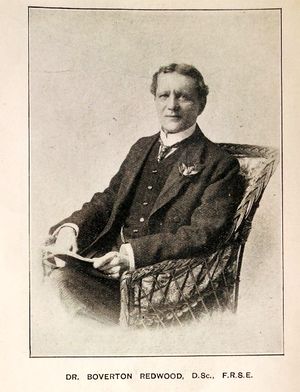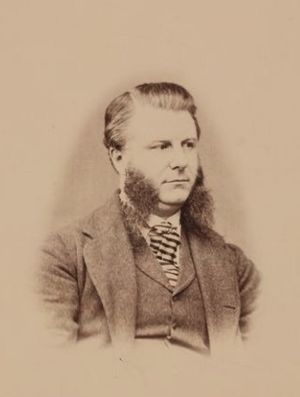Thomas Boverton Redwood
Biography
The original version of this article was created by Francesco Gerali, 2019 Elizabeth & Emerson Pugh Scholar in Residence at the IEEE History Center
It is recommended this article be cited as:
F. Gerali (2019). Thomas Boverton Redwood, Engineering and Technology History Wiki. [Online] Available: https://ethw.org/Thomas_Boverton_Redwood
Redwood, Sir (Thomas) Boverton, first baronet (1846-1919) was born in a high bourgeoisie family active in the chemical and pharmaceutical industry. He graduated in London at the University College School, and started to work with his father as a chemist. Redwood's turn toward the petroleum sector was between 1866 and 1869, when he was elected the first member and then secretary of the Petroleum Association of London, one of the earlier professional society in the sector, which activities are continued first by the Institute of Petroleum Technologists, and then the Institute of Petroleum. Redwood's skills in analytical chemistry made of him an expert in the subject of petroleum, derived oils, and flashing points. In 1877, he was invited by the British leading scholar in oil chemistry, Frederick Augustus Abel (1827-1902), better known for his achievements in explosives studies,[1] to work on flashing points standards.
The studies developed by Redwood (partly during a research stay in the USA) in the following two years resulted in the 1879 amendment (no 161) of the Petroleum Act, initially passed in 1871,[2] and the improvement of the test and instrument earlier conceived by Abel. At this point of his career in petroleum studies, after the mentoring and then partnership with Abel and the numerous scientific acknowledgements, Redwood in the early 1880s was in the cadre of those scientists that pioneered the early modern science and technology of petroleum. Between 1880 and 1883, he completed original studies on the behavior of petroleum at different pressure and temperatures, and toured Europe, the Caucasus and India, focusing his research on petroleum storage and transportation. In 1885-1886, he did consulting studies on the safety standards for the making of kerosene lamps, and also developed an improved version of viscometer[3] that soon after became a standard tool in the petroleum industry of many countries. In 1889, Redwood, together with James Dewar (1842-1923),[4] Scottish chemist expert in gas liquefaction, patented a distillation process at controlled pressure and temperature, which could break an convert heavy petroleum into light oils, which can be considered an early version of the thermal cracking process.
In the following decade, Redwood engineered other testing instruments for the petroleum storage and transportation, and was consultant for the plan of feasibility for the shipping via Suez Canal of petroleum from the East Indies to Europe. Eventually, in 1899, after more than 30 years of patents and acknowledgements, he established in London what became the leading international petroleum consulting firm of the early 20th century. He personally travelled in many countries and sent his associated consultant geologists and engineers worldwide. Boverton Redwood passed away on June 4th, 1919, in London at the age of 73 and was one of the most influential European petroleum scientists and technical consultants of his times.
Advisory positions in public offices
- Corporation of the City of London under the Petroleum Acts and the Thames
- Conservancy
- Home Office Committee on Acetylene Generators
- Royal Commission on Coal
- Royal Commission on the Supply of Food and Raw Materials in Time of War.
- Royal Commission on Oil fuel for the Admiralty
- Petroleum Research Department
- Petroleum Supply Branch at the Ministry of Munitions
- Mining for the Advisory Council
- Gas Traction Committee
- Committee on the Use of Alcohol as Fuel
Affiliation to professional and learned societies
- Pharmaceutical Society of Great Britain
- Petroleum Association of London
- Institute of Chemistry
- Chemical Society of London
- Society of Chemical Industry (Vice-President, and President 1907-08)
- Geological Society of London
- Institute of Mining Engineers
- Imperial Russian Technical Society
- American Philosophical Society
- Institute of Petroleum Technologists (founding member and President 1913-15).
Published works
- Redwood, B. 1871. “New readings of the Petroleum Acts”. Pharmaceutical Journal, series 3, 1, 1025-26
- Redwood, B. 1871. “The estimation of colour in liquids”. Pharmaceutical Journal, series 3, 1, 344
- Redwood, B. 1872. Evidence before the Select Committee of the House of Lords on the Petroleum Bill 1872 (135). IX House of Lords, London, privately printed.
- Redwood, B. 1875-76. “Testing paraffin oil: explosion of lamps”. English Mechanics, 22, 355, 376, 458
- Redwood, B. 1876. “Description of Mr. R. P. Wilson’s Chrono-thermometer, for use in testing mineral oils”. English Mechanics 22, 496
- Redwood, B. 1876. The Secretary’s Reports of his Mission to the United States and Canada, London, privately printed.
- Redwood, B. 1879. “Life in the more recently developed oil fields of the United States”. Pharmaceutical Journal and Transactions 38, 753-755.
- Redwood, B. 1883. On the Present Position & Future Prospects of the Russian (Caucasian) Petroleum Industry. Waterlow & Sons Limited, London.
- Redwood, B. 1884. “The determination of the percentage of oil in paraffin scale”. Journal of the Society of Chemical Industry 3 (8), 430-432.
- Redwood, B. 1886. Cantor Lectures on Petroleum and Its Products. Society for the Encouragement of Arts, Manufactures, and Commerce, London.
- Redwood, B. 1886. Petroleum: Its Production and Uses. Van Nostrand, New York.
- Redwood, B. 1887. “Notes of a recent visit to some of the petroleum-producing territories of the United States and Canada”. Scientific American 24 (610), 9743-9744; (611), 9765.
- Redwood, B. 1889. On The Domestic Uses of Petroleum Products. Kenny & Co., London.
- Redwood, B. 1890. “The oil-fields of India: notes on the petroleum deposits of Burma, Assam, the Punjab, and Baluchistan”. Journal of Society of Chemical Industry, 9, 359-370, 441–443.
- Redwood, B. & Topley, W. 1891. Report by Boverton Redwood … and William Topley … on the Riacho-doce and Camarajibe Shale Deposits on the Coast of Brazil, near Maceió. Corporate publication, London.
- Redwood, B. 1894. The Transport of Petroleum in Bulk. Institution of Civil Engineers, London.
- Redwood, B. 1896. Petroleum; A Treatise on the Geographical Distribution and Geological Occurrence of Petroleum and Natural Gas; The Physical and Chemical Properties, Production, and Refining of Petroleum and Ozokerite; The Characters and Uses, Testing, Transport, and Storage of Petroleum Products; And the Legislative Enactments Relating Thereto; Together With a Description of the Shale Oil and Allied Industries; And a Full Bibliography. 3 Volumes. C. Griffin & Co., London (2nd edn, 1906; 3rd edn, 1913; 1922, 4th edn, 1926).
- Thomson, J.H. & Redwood, B. 1901. Handbook on Petroleum for Inspectors under the Petroleum Acts and for Those Engaged in the Storage, Transport, Distribution, and Industrial Use of Petroleum and Its Products and Calcium Carbide, with Suggestions on the Construction and Use of Mineral oil Lamps. Charles Griffin & Co., London (revised by Aston Cooper-Key) (2nd edn, 1906; 3rd edn, 1913).
- Thomson, J.H. & Redwood, B. 1902. The Petroleum Lamp, Its Choice and Use. A Guide to the safe employment of Mineral Oil in what is commonly termed the Paraffin Lamp. Charles Griffin & Co., London (2nd edn, 1906; 3rd edn, 1913).
- Redwood, B. 1910. “Guide to the Oil Companies. Particulars of the Principal Oil Companies, with Alphabetical List of Directors. With Introduction by Sir Boverton Redwood”. Pall Mall Gazette. London.
- Redwood, B. 1913. “The future of fuel oil”. Journal of the Royal Society of Arts 62 (3188), 103-116.
- Redwood, B. (ed.) 1919. A Treatise on British Mineral Oil. G. Griffith & Co., London.
- Redwood, B. & Inter-Departmental Committee on Alcohol Motorfuel (Great Britain) 1919. Report of the Inter-Departmental Committee of Various Matters Concerning the Production and Utilization of Alcohol for Power and Traction Purposes. HMSO, London.
- Redwood, B. & Eastlake, A. 1915. Petroleum Technologist’s Pocket-Book. Charles Griffin & Co., London (2nd edn, 1923).
See also
References
Anonimous. “The Late Sir. Boverton Redwood”. Journal of the Institution of Petroleum Technologists and Record of Transaction V, no 20 (1919): 241-249.
Corley, Thomas Anthony Buchanan. A history of the Burmah Oil Company, 1866-1924. London: Heinemann, 1983.
Dyer, B., T. E. Thorpe, J. A. Harker, C. Simmonds, and F. Mollwo Perkin. “Obituary Notices: Sir William Crookes, O.M., 1832–1919; Thomas Fairley, 1843–1919; Walter William Fisher, 1842–1920; Antoine Paul Nicolas Franchimont, 1844–1919; Harold Cecil Greenwood, 1887–1919; Charles Edward Groves, 1841–1920; John Holmes, 1871–1919; Sir Boverton Redwood, Bart., 1846–1919; John Charles Umney, 1868–1919”. Journal of the Chemical Society, Transactions. 117: (1920): 444-472.
Ferrier, R.W. 1982. The History of the British Petroleum Company. The Developing Years 1901-1932. Vol. 1. Cambridge: Cambridge University Press.
Sorkhabi, R. 2015. “A history of petroleum geoscience textbooks”. Oil-Industry History 16, 165-208.
Sorkhabi, Rasoul. 2018. “Sir Thomas Boverton Redwood (1846–1919): a watershed in the British oil industry”. In Craig, J., Gerali, F., Macaulay, F. & Sorkhabi, R. (eds) 2018. History of the European Oil and Gas Industry. Geological Society, London, Special Publications, 465, 423–451.
Grace’s Guide. 2016. Thomas Boverton Redwood. http://www.gracesguide.co.uk/Thomas_Boverton_Redwood
Williams, T.I. A History of the British Gas Industry. Oxford: Oxford University Press, 1981.
Further Reading
- ↑ https://www.worldofchemicals.com/340/chemistry-articles/frederick-augustus-abel-co-inventor-of-cordite.html
- ↑ https://api.parliament.uk/historic-hansard/lords/1879/aug/01/committee
- ↑ https://www.britannica.com/technology/viscometer
- ↑ https://discovery.nationalarchives.gov.uk/details/r/dd9dd51c-c406-4cc0-844c-57270872124a

